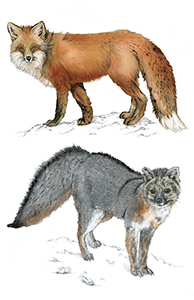Home → Fish & Wildlife → Wildlife → Species Information → Mammals → Foxes
Foxes
Vulpes vulpes and Urocyon cinereoargenteus
On this page:

Maine is fortunate to have two species of fox, the red fox (Vulpes vulpes) and gray fox (Urocyon cinereoargenteus). Both species are similar in size, but there are some important differences in their appearance, behavior, and distribution.
Habitat
Foxes are found in diverse habitats and are quite tolerant of living near people. Foxes are common in agricultural landscapes and tend to do well with a mix of forest and fields. Coyotes are predators of foxes but tend to be more wary of people, so foxes avoid coyotes by living near people. The red fox is abundant and widespread, occurring in all counties in Maine. The gray fox is abundant in southern and mid-coast Maine and continues to expand into western and central parts of the state.
Diet
Foxes are omnivores and eat a wide variety of plants and animals, depending on the season. Small birds and mammals are consumed, including mice, voles, rats, rabbits, and bird eggs. Foxes also eat insects, snakes, carrion, berries, apples, corn, seeds, and nuts. Foxes are primarily nocturnal, including hunting during dawn and dusk, but foxes are occasionally seen out during the day, particularly during the spring/summer when rearing pups.
Distinctive Characteristics
Red Fox
Adult red foxes weigh 7-15 pounds and have a distinct red/orange appearance, white chest, black legs, and bushy white-tipped tail. Silver or cross foxes are a melanistic form of the red fox; they appear black, silver or a combination of red/black/grey and are less common than the typical red phase. Red foxes have keen eyesight and hearing, and are very agile, jumping up to six feet high. Red foxes have a special method of hunting with impressive pounces on prey hidden under the snow or ground.
Gray Fox
Gray foxes weigh about 10 pounds and are distinguished by their grizzled coloration, a hint of red on the neck, ears, and lower legs, and a black stripe down their tail. Gray fox are the only member in the canid (dog) family in North America that can climb trees. Red foxes can climb, but not as well as gray foxes.
Nocturnal/Diurnal
Fox tend to be most active during dawn and dusk but are commonly seen during both daylight and nighttime hours.
Seasonal Changes
Seasonal changes for foxes primarily include changes in food availability, which may influence their home range.
Reproduction & Family Structure
Though slightly varied between red and gray fox, breeding usually occurs anytime between January – March and gestation is anywhere from 50 and 63 days, giving birth to litters that range from three-six pups on average in the spring. Gray fox specifically breeds with a lifelong companion. Both male and female of gray and red fox provide food and care for young for up to three months and teach their young to hunt. Gray and red foxes do not interbreed.
Family groups stay together until mid-September, when pups begin to disperse from their natal home range. Males generally disperse twice the distance of females, commonly moving 20-40 miles before finding new territories. Quite often female offspring will remain close to or share their mother's territories. Related females tolerate each other's presence, but territories of unrelated females are clearly defined and adhered to.
Survival & Threats
Fox can become prey to coyotes, so you usually won’t find fox in areas where coyotes are common. Other threats include exposure to rat poison since fox are exceptional rodent control. Humans are also a mortality source, through hunting and trapping, or vehicle collisions.
Management & Conservation
Red and gray foxes are considered furbearers and MDIFW regulates and manages the trapping and hunting of foxes. All foxes that are trapped or hunted must be registered and tagged. Biologists monitor the harvest data to ensure that trapping and hunting levels are sustainable.
Living with Wildlife
How to Prevent or Resolve Conflicts with Foxes
Research suggests that humans create the conditions for conflict by deliberately or inadvertently providing animals with food and shelter.
Preventing or removing access to these attractants is the first essential step to resolving a wildlife problem. This includes eliminating access to shelter, being smart about garbage, planting native plants to attract birds rather than using bird seed, protecting poultry and livestock, and being a responsible pet owner.
Learn more about how to prevent or resolve conflicts with foxes